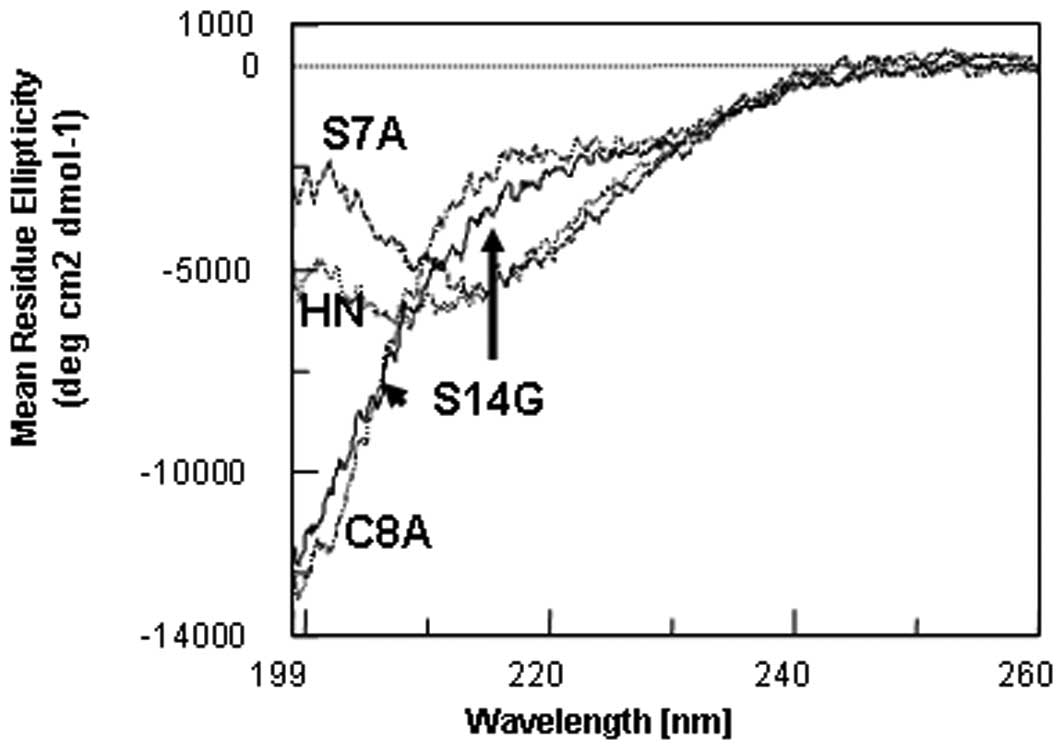|
1
|
Fields K, Falla TJ, Rodan K and Bush L:
Bioactive peptides: signaling the future. J Cosmet Dermatol.
8:8–13. 2009. View Article : Google Scholar : PubMed/NCBI
|
|
2
|
Aneiros A and Garateix A: Bioactive
peptides from marine sources: pharmacological properties and
isolation procedures. J Chromatogr B Analyt Technol Biomed Life
Sci. 803:41–53. 2004.PubMed/NCBI
|
|
3
|
Mason JM: Design and development of
peptides and peptide mimetics as antagonists for therapeutic
intervention. Future Med Chem. 2:1813–1822. 2010. View Article : Google Scholar : PubMed/NCBI
|
|
4
|
Otvos L Jr: Synthesis of a multivalent,
multiepitope vaccine construct. Methods Mol Biol. 494:263–273.
2008. View Article : Google Scholar : PubMed/NCBI
|
|
5
|
Hashimoto Y, Niikura T, Tajima H, et al: A
rescue factor abolishing neuronal cell death by a wide spectrum of
familial Alzheimer’s disease genes and Abeta. Proc Natl Acad Sci
USA. 98:6336–6341. 2001.PubMed/NCBI
|
|
6
|
Yamagishi Y, Hashimoto Y, Niikura T and
Nishimoto I: Identification of essential amino acids in Humanin, a
neuroprotective factor against Alzheimer’s disease-relevant
insults. Peptides. 24:585–595. 2003.PubMed/NCBI
|
|
7
|
Hashimoto Y, Kurita M and Matsuoka M:
Identification of soluble WSX-1 not as a dominant-negative but as
an alternative functional subunit of a receptor for an
anti-Alzheimer’s disease rescue factor Humanin. Biochem Biophys Res
Commun. 389:95–99. 2009.
|
|
8
|
Hashimoto Y, Niikura T, Ito Y, et al:
Detailed characterization of neuroprotection by a rescue factor
humanin against various Alzheimer’s disease-relevant insults. J
Neurosci. 21:9235–9245. 2001.PubMed/NCBI
|
|
9
|
Ikonen M, Liu B, Hashimoto Y, et al:
Interaction between the Alzheimer’s survival peptide humanin and
insulin-like growth factor-binding protein 3 regulates cell
survival and apoptosis. Proc Natl Acad Sci USA. 100:13042–13047.
2003.
|
|
10
|
Terashita K, Hashimoto Y, Niikura T, et
al: Two serine residues distinctly regulate the rescue function of
Humanin, an inhibiting factor of Alzheimer’s disease-related
neurotoxicity: functional potentiation by isomerization and
dimerization. J Neurochem. 85:1521–1538. 2003.PubMed/NCBI
|
|
11
|
Armas A, Sonois V, Mothes E, Mazarguil H
and Faller P: Zinc(II) binds to the neuroprotective peptide
humanin. J Inorg Biochem. 100:1672–1678. 2006. View Article : Google Scholar : PubMed/NCBI
|
|
12
|
Arakawa T, Niikura T and Kita Y: The
biological activity of Humanin analogs correlates with structure
stabilities in solution. Int J Biol Macromol. 49:93–97. 2011.
View Article : Google Scholar : PubMed/NCBI
|
|
13
|
Arisaka F, Arakawa T, Niikura T and Kita
Y: Active form of neuroprotective Humanin, HN, and inactive analog,
S7A-HN, are monomeric and disordered in aqueous phosphate solution
at pH 6.0; No correlation of solution structure with activity.
Protein Pept Lett. 16:132–137. 2009. View Article : Google Scholar
|
|
14
|
Thies MJ, Talamo F, Mayer M, et al:
Folding and oxidation of the antibody domain C(H)3. J Mol Biol.
319:1267–1277. 2002. View Article : Google Scholar : PubMed/NCBI
|
|
15
|
Arakawa T, Niikura T, Tajima H and Kita Y:
The secondary structure analysis of a potent Ser14Gly analog of
antiAlzheimer peptide, Humanin, by circular dichroism. J Pept Sci.
12:639–642. 2006. View
Article : Google Scholar : PubMed/NCBI
|
|
16
|
Arakawa T, Kita Y and Niikura T: A rescue
factor for Alzheimer’s diseases: discovery, activity, structure,
and mechanism. Curr Med Chem. 15:2086–2098. 2008.
|
|
17
|
Pistolesi S, Rossini L, Ferro E, Basosi R,
Trabalzini L and Pogni R: Humanin structural versatility and
interaction with model cerebral cortex membranes. Biochemistry.
48:5026–5033. 2009. View Article : Google Scholar : PubMed/NCBI
|
|
18
|
Maurer-Stroh S, Debulpaep M, Kuemmerer N,
et al: Exploring the sequence determinants of amyloid structure
using position-specific scoring matrices. Nature Methods.
7:237–242. 2010. View Article : Google Scholar : PubMed/NCBI
|
|
19
|
Nozaki Y and Tanford C: The solubility of
amino acids and two glycine peptides in aqueous ethanol and dioxane
solutions. Establishment of a hydrophobicity scale. J Biol Chem.
246:2211–2217. 1971.PubMed/NCBI
|
|
20
|
Richardson JS and Richardson DC:
Principles and patterns of protein conformation. Prediction of
Protein Structure and the Principles of Protein Conformation.
Fasman G: Plenum Press; New York: pp. 43–75. 1989
|
|
21
|
Kyte J and Doolittle RF: A simple method
for displaying the hydropathic character of a protein. J Mol Biol.
157:105–132. 1982. View Article : Google Scholar : PubMed/NCBI
|
|
22
|
Zhou X, Liu J, Li B, Pillai S, Lin D, Liu
J and Zhang Y: Assembly of glucagon (proto)fibrils by longitudinal
addition of oligomers. Nanoscale. 3:3049–3051. 2011. View Article : Google Scholar : PubMed/NCBI
|
|
23
|
Arvinte T, Cudd A and Drake AF: The
structure and mechanism of formation of human calcitonin fibrils. J
Biol Chem. 268:6415–6422. 1993.PubMed/NCBI
|
|
24
|
Steckmann T, Awan Z, Gerstman BS and
Chapagain PP: Kinetics of peptide secondary structure conversion
during amyloid β-protein fibrillogenesis. J Theor Biol. 301:95–102.
2012.
|
|
25
|
Kodali R, Williams AD, Chemuru S and
Wetzel R: Abeta(1–40) forms five distinct amyloid structures whose
beta-sheet contents and fibril stabilities are correlated. J Mol
Biol. 401:503–517. 2010.
|
|
26
|
Macchi F, Hoffmann SV, Carlsen M, et al:
Mechanical stress affects glucagon fibrillation kinetics and fibril
structure. Langmuir. 27:12539–12549. 2011. View Article : Google Scholar : PubMed/NCBI
|


















